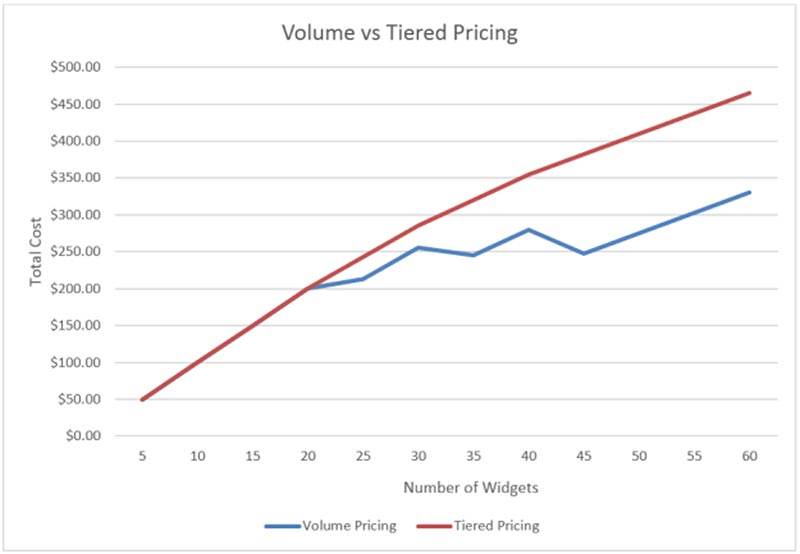Does your SaaS business tend to sell its subscriptions in bulk?
If you’re currently offering a discount for volume purchases, you may be losing revenue. There’s another pricing model that you could leverage instead.
But first, let’s take a quick look at how volume pricing works.
With a volume pricing strategy, the cost for all units purchased is reduced based on how many units your customers buy. Your units could be anything from gigabytes to user accounts. We’ll use widgets for this example.
Imagine the cost of a widget is $10 for the first 20, but drops to $8.50 if 21 to 30 widgets are purchased.
In volume pricing, that means every widget purchased by a customer ordering 30 widgets costs $8.50, for a total of $255.
Seems like a good deal for everyone involved, right? It might be, but let’s consider a different model.
With tiered pricing, the customer would pay $10 each for the first 20 widgets, then $8.50 each for the 10 widgets after that. A little extra math results in a total of $285.
A $30 difference may not seem like much, but over time, volume pricing can take a big chunk out of your business’s bottom line.
Just have a look at the graph below illustrating this exact pricing model, comparing volume vs. tiered pricing. It includes additional discounts at 31 to 40 widgets and 41+ widgets for both plans.

If you look closely, you’ll see this widget-selling business makes less money for selling 35 widgets vs. 30, and much less for selling 46 vs. 40.
Replace widgets with SaaS users, gigabytes, or any units offered by your own business and the revenue difference is clear.
Which businesses stand to benefit from tiered pricing SaaS models?
Tiered pricing isn’t right for every SaaS business, but it could be right for yours. It’s a pricing strategy that’s often most effective when your business has a captive market that views your product or service as essential.
This might explain why many highly successful businesses like Squarespace, HubSpot, Crazy Egg, and Price Intelligently have chosen a tiered pricing SaaS model for their products. In fact, tiered pricing is one of the most common SaaS billing models today.
How do you position your SaaS product as essential? It all boils down to perceived value.
The founder of Hostfi evolved his company’s pricing from cost-based to value-based. After initially pricing based on his own server capacity, he switched to tiers based on the number of devices his customers were using. The move made customers feel they were getting more value from their plan and incentivized them to upgrade to higher tiers for more features as their needs increased.
People will pay for what they want and what they can afford. With attractive value-based pricing, a tiered pricing model makes the most of what people are willing to spend for value. It also opens the door to creative pricing.
Successful tiered pricing requires smart value metrics
For Squarespace, it’s features. And for HubSpot? Contacts.
Crazy Egg focuses on page views, while Price Intelligently looks at data sprints. What exactly are we listing here? Value metrics.
Are your products better grouped by quality, quantity, type of service, or something different? Perhaps usage, flexibility, brand credibility, cost certainty, or content come into play.
Tiered pricing creates opportunities to connect value to product in a variety of ways. The best SaaS businesses carefully build their tiers around value metrics customers are looking for. They also get creative with presentation.
Tiered pricing demands the right recurring billing infrastructure
In our widget example earlier, a little extra math was needed to make the switch from volume pricing to tiered pricing.
Volume pricing can be hard enough to track manually at scale; tiered pricing is nearly impossible without automation.
Automated recurring billing software eases the transition, and also helps with:
- valuable churn prevention, and
- revenue leakage elimination features like dunning management.
These agile SaaS billing platforms can also automate invoicing, subscription management, and even plan changes as customer needs grow. And they can handle other pricing strategies that help increase revenue too.
An adaptive recurring billing system, such as Stax Bill, can adeptly handle free-trial conversions, subscription add-ons, usage-based pricing strategies, discount/coupon promotions, and more. All of this is in addition to flexibility in handling combinations and variations of fixed recurring and one-time charges, and even hybrid billing.
As SaaS businesses scale and adjust their pricing strategies, concerns about accounting, revenue recognition compliance, and secure payment methods and gateways grow as well.
A modern recurring billing solution puts these worries to rest with full catalog flexibility, dual-entry accounting, and industry-leading security infrastructure and operations.
Versatile billing platforms even integrate with popular software you may already be using, such as NetSuite, Salesforce, Quickbooks, and more. This ensures your total revenue operations process runs smoothly and efficiently to maximize your success.
Tiered pricing requires the right billing infrastructure. A digital transformation that includes the right agile recurring billing platform can give your SaaS business just that.








